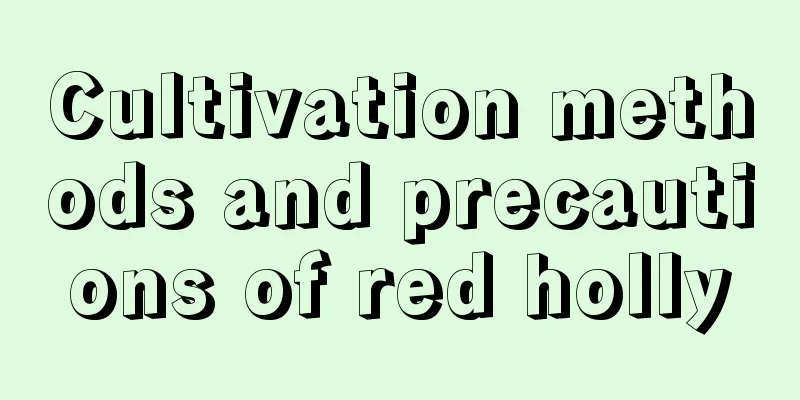Cultivation methods and precautions of red holly

1. Maintenance methods1. Temperature: Red holly likes warmth and its cold resistance is not good. Therefore, it can be maintained between fifteen and twenty-eight degrees. If planted in a place with very cold winters, certain cold-proof measures must be taken. 2. Light: Ilex redus is a light-loving plant. However, its shade tolerance is also good. In daily maintenance, it is better to provide sufficient light. Especially when the plant is growing fast, blooming, or bearing fruit, it should not be too dark. In winter, good light is also helpful for its wintering. 3. Watering: Red fruit holly likes moisture, but it is not tolerant to waterlogging. When watering, just water thoroughly and keep it moist during the growth stage, but don't let water accumulate. Some areas have more rain in the summer, so it is best to take some measures to drain away the excess rainwater. 4. Fertilization: Red fruit holly has good adaptability. Generally speaking, it does not need too much topdressing. It is better to apply it once every half a month or a month. Another thing to pay attention to is the basal fertilizer, which needs to be sufficient. 2. Breeding techniques1. Reproduction: Seeding propagation can be adopted. The fruits can be collected in autumn, and the seeds can be taken out after removing the peel. Then store it in moist sand. The best time to sow is in March of the following spring. Since it grows relatively slowly, it takes a long time for it to grow up. 2. Pruning: Red fruit holly has a very strong sprouting ability and is relatively resistant to pruning, so this step is more important. One is pinching in spring to promote more flowering after branching. Another thing is to prune some old and dry leaves during the dormant period. 3. Problem diagnosis and treatment1. Diseases: The diseases of red holly mainly harm the leaves, especially "leaf spot disease". It can be treated with carbendazim and the diseased leaves should be cut off in time. 2. Pests: The main pest is called "white wax scale", which is very harmful in itself and can also spread diseases. They are concentrated among the branches and leaves and need to be sprayed with pesticides in time for prevention and control. IV. Other issues1. Toxicity: It is non-toxic and has strong resistance to many toxic gases. 2. Can it be grown at home? Due to its very large size, it is generally not grown at home, but the fruit branches can be placed in a vase for viewing. |
<<: Cultivation methods and precautions of red clover
>>: Cultivation methods and precautions of red gentian
Recommend
How to grow ginger lotus, pictures of ginger lotus
1. Suitable soil Ginger lily does not have very h...
Main points for plum blossom maintenance
1. Maintenance points 1. Soil: It is better to us...
What to do if azalea root rots
1. Watering One of the reasons is excessive water...
How to grow Mingyue succulent well
Mingyue succulent growing conditions The suitable...
Is Chlorophytum suitable for indoor cultivation?
It is better to keep spider plants at home, and i...
How to propagate Staghorn Begonia and what to pay attention to
How to propagate Staghorn begonia The main ways t...
How often should I water my Green Diamond?
How often should I water my Green Diamond? The fr...
Precautions for dividing the pot of Aspidistra
time The Aspidistra can be divided and planted se...
When is the best time to transplant blueberry trees?
When transplanting blueberry trees, you should pa...
How often should I water Schefflera?
How often should I water Schefflera? The frequenc...
The orchid stopped blooming after being repotted (what causes it to not bloom after transplanting)
Why does the orchid not bloom after being divided...
How often should I water my boxwood?
How often should I water my boxwood? In spring, s...
What is the flower language of pansy?
1. Its flower language Its flower language repres...
How to use potassium dihydrogen phosphate to make flowers grow well (how to fertilize flowers at home)
Potassium dihydrogen phosphate is a phosphorus-po...
Water and fertilizer management of Tradescantia
Water Management for Tradescantia Tradescantia li...









